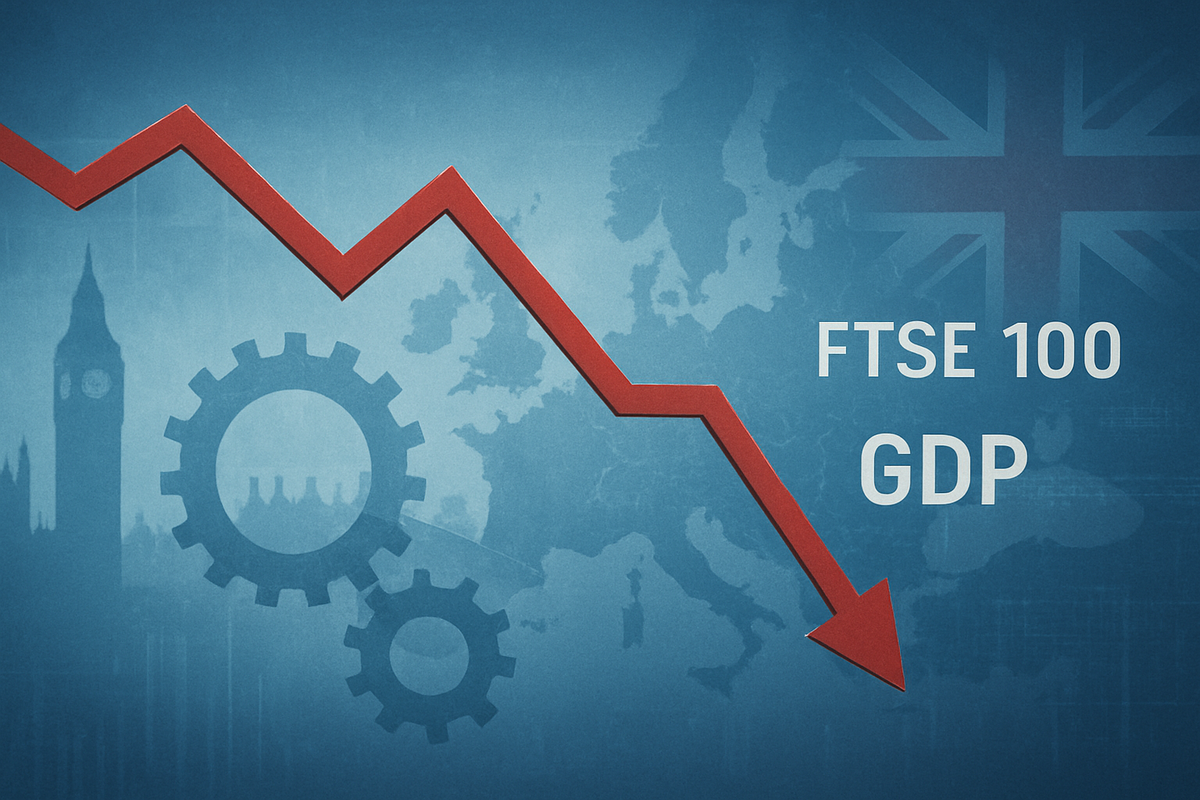FTSE 100 Stumbles as UK GDP Growth Disappoints, Signaling Deeper Economic Woes

The UK economy has hit a snag, with weaker-than-expected Gross Domestic Product (GDP) growth in the third quarter of 2025 sending ripples of concern through financial markets. This sluggish economic performance, announced on November 13, 2025, has directly contributed to a significant slide in the FTSE 100 index (INDEXUK: UKX), which closed down 1.05% on the day, after having touched record highs earlier in the month. The immediate implications are a weaker Pound Sterling, heightened expectations for an interest rate cut by the Bank of England (BoE), and a generally subdued investor sentiment that extends beyond British shores into the broader European markets.
This economic deceleration suggests a challenging period ahead for the UK, as businesses and consumers grapple with persistent headwinds. The confluence of disappointing growth figures and a retreating benchmark index paints a picture of an economy struggling to find its footing, prompting analysts to reassess their outlook for both the short and long term.
Detailed Economic Downturn and Market Response
The UK's economic expansion in Q3 2025 proved to be a significant disappointment, with GDP growing by a mere 0.1% quarter-on-quarter (QoQ), falling short of the market's 0.2% forecast and decelerating from the 0.3% growth seen in Q2. On a monthly basis, September witnessed a contraction of 0.1%, defying expectations for flat growth. Annually, Q3 GDP rose by 1.3%, also below the anticipated 1.4%. This sluggishness was attributed to a multi-faceted slowdown across several key sectors.
The services and construction sectors experienced a notable deceleration, while the production sector contracted. A particularly sharp drop in car manufacturing, down 28.6% month-on-month in September, partly due to a cyber-attack on Jaguar Land Rover (LSE: JLR), significantly impacted the figures. The pharmaceutical industry also saw a decline, and overall business investment fell by 0.3% QoQ. These factors, combined with higher taxes and soft overseas activity, created a challenging environment for the UK economy to gain momentum.
The FTSE 100's reaction on November 13, 2025, was swift and negative. The index, which had earlier in November reached an all-time high of 9,930.09 points, retreated to close at 9,807.68. Beyond the GDP figures, the slide was exacerbated by weaker-than-expected corporate earnings from major companies such as Aviva (LSE: AV) and 3i Group (LSE: III), alongside muted oil prices which weighed on energy giants like BP (LSE: BP) and Shell (LSE: SHEL). The Pound Sterling (GBP) also immediately weakened against both the Euro (EUR) and the US Dollar (USD), a reaction compounded by earlier weak employment data showing the unemployment rate rising to 5.0% in September, its highest since February 2021.
Key players involved in this unfolding economic narrative include the Bank of England, whose monetary policy decisions are now under intense scrutiny; the UK government, particularly Chancellor Rachel Reeves, who faces increased pressure ahead of an anticipated budget later in November; and the various sectors and companies whose performance dictates the broader economic health. Initial market reactions clearly signal a loss of confidence and a recalibration of expectations, with bond yields slipping as investors brace for potential interest rate cuts.
Companies Navigating the Economic Headwinds: Winners and Losers
The weaker-than-expected UK GDP growth and the subsequent FTSE 100 slide create a divergent landscape for public companies, with some poised to benefit from defensive positions or international exposure, while others face significant headwinds due to their reliance on domestic consumer spending and business investment.
Companies operating in defensive sectors are generally better positioned to weather the economic storm. Consumer Staples firms, providing essential goods like food and household products, tend to maintain stable demand. Giants such as Unilever (LSE: ULVR) and British American Tobacco (LSE: BATS), with their vast global operations, also benefit from a weaker Pound Sterling, which enhances the value of their repatriated overseas earnings. Similarly, Healthcare stalwarts like GlaxoSmithKline (LSE: GSK) and AstraZeneca (LSE: AZN) are expected to remain resilient due to consistent demand for medical services and their strong international presence. Utilities (e.g., National Grid (LSE: NG) and Centrica (LSE: CNA)) and Telecommunications (e.g., BT (LSE: BT.A) and Vodafone (LSE: VOD)) also fall into this resilient category, as their services are deemed essential regardless of economic conditions.
Furthermore, companies with a strong international revenue base are significantly insulated from the domestic slowdown. Over 70% of FTSE 100 constituents generate revenue outside the UK, making the index less dependent on the local economy. Beyond the aforementioned consumer staples and healthcare firms, companies like Rolls-Royce (LSE: RR.) are examples of businesses that thrive on global demand, with a weaker pound further boosting their profitability. Even within the retail sector, discount retailers like Primark (part of Associated British Foods (LSE: ABF)) are expected to perform well as consumers become more price-conscious, a trend dubbed "frugal luxury." Paradoxically, ultra-luxury brands such as Bentley and Burberry (LSE: BRBY) also tend to remain resilient, as their high-net-worth clientele are less affected by economic downturns. The prospect of interest rate cuts could also offer a glimmer of hope for housebuilders like Vistry (LSE: VSTY), Taylor Wimpey (LSE: TW.), and Persimmon (LSE: PSN), potentially stimulating the housing market by making mortgages more affordable.
Conversely, companies heavily reliant on domestic consumer discretionary spending are likely to suffer. This includes a broad range of retailers not in the discount segment, and some hospitality and home improvement firms like Kingfisher Plc (LSE: KGF) and Wickes Group Plc (LSE: WIX). Reduced consumer confidence means less spending on non-essential goods and services, directly impacting their top and bottom lines. Import-dependent sectors will also face increased costs due to a weaker Pound, squeezing profit margins for domestic retailers and certain construction firms. The commercial construction sector is already seeing sharp declines as businesses defer investments in new offices and retail spaces. Events like the cyberattack on Jaguar Land Rover (LSE: JLR), which significantly disrupted car manufacturing and contributed to the Q3 GDP slump, highlight the vulnerability of specific manufacturing and industrial segments to unforeseen disruptions and broader economic malaise. Recruitment agencies and HR services are also likely to see declining revenues as businesses adopt a cautious approach to hiring. Finally, some financial institutions and private equity firms, such as 3i Group (LSE: III), have already expressed caution on deploying capital, indicating a challenging transaction environment.
Wider Significance: Echoes and Ripple Effects
The UK's weaker-than-expected Q3 GDP growth and the subsequent FTSE 100 slide are not isolated incidents but rather critical indicators that fit into broader global economic trends, while also carrying specific implications for the UK and European markets. This event underscores a prevailing sentiment of economic fragility across developed economies, grappling with persistent inflation, elevated interest rates, and geopolitical uncertainties.
Globally, this slowdown aligns with a general deceleration in economic momentum observed across various major economies. For the UK, it solidifies concerns about its post-Brexit economic trajectory and its ability to maintain growth amidst international headwinds. The ripple effects are considerable: a weaker UK economy inevitably impacts its trading partners, particularly within Europe. While the direct impact of UK GDP on broader European indices might be limited compared to internal European economic data, the UK's struggles contribute to a generally cautious sentiment across the continent. This is compounded by other concerning European economic indicators, such as weaker-than-expected eurozone industrial production and negative German consumer data, suggesting a shared struggle for economic momentum. Companies with significant exposure to the UK market, whether through sales or supply chains, will feel the pinch, potentially leading to revised earnings forecasts and investment decisions.
From a regulatory and policy perspective, the disappointing GDP figures intensify the pressure on the Bank of England to consider an interest rate cut. Market odds for a December rate cut have significantly increased, reflecting the central bank's dual mandate of controlling inflation and supporting economic growth. A rate cut, while potentially stimulating growth, also carries risks of reigniting inflationary pressures. For the UK government, particularly Chancellor Rachel Reeves, the sluggish growth adds urgency and complexity to the upcoming budget. The need to meet borrowing rules while simultaneously attempting to stimulate the economy through fiscal policy presents a tightrope walk, with potential tax increases or spending cuts that could further impact consumer and business confidence.
Historically, periods of weak economic growth and declining market indices often precede shifts in monetary policy. The current situation bears some resemblance to post-crisis recovery periods where central banks faced the dilemma of supporting growth without fueling inflation. However, the unique combination of high inflation alongside weak growth (stagflationary concerns) makes the current environment particularly challenging. Comparisons can be drawn to previous periods where external shocks or internal policy decisions led to sustained periods of subdued economic performance, highlighting the need for careful and coordinated policy responses to prevent a deeper downturn.
What Comes Next: Navigating Uncertainty
The immediate future for the UK economy and its markets is characterized by a blend of uncertainty and anticipation, with both short-term adjustments and long-term strategic pivots on the horizon.
In the short term, all eyes will be on the Bank of England's next monetary policy meeting. The increased probability of an interest rate cut in December suggests a potential easing of borrowing costs, which could offer some relief to businesses and mortgage holders. However, the impact of such a cut might not be immediate or substantial enough to rapidly reverse the current economic deceleration. Businesses are likely to maintain a cautious stance on investment and hiring, especially with the upcoming UK budget expected to outline further tax changes. The Pound Sterling's performance will remain volatile, reacting to economic data and central bank signals.
Looking long term, the UK economy faces the imperative of strategic adaptation. Companies with robust balance sheets and diversified revenue streams will be better positioned to navigate the challenges. There may be a continued shift towards defensive sectors and companies with strong international exposure, as investors seek stability and growth opportunities beyond the domestic market. Innovation and efficiency gains will become paramount for businesses to maintain competitiveness amidst subdued demand and cost pressures. Potential strategic pivots could include a greater focus on digital transformation, supply chain resilience, and exploring new international markets.
Market opportunities might emerge from the current bearish sentiment. Lower valuations for many UK stocks, particularly in the mid and small-cap sectors, could present buying opportunities for long-term investors if the economic outlook shows signs of improvement. However, significant challenges persist, including persistent inflationary pressures, the tight labor market, and the ongoing geopolitical landscape. Potential scenarios range from a gradual, albeit slow, recovery supported by monetary easing, to a more prolonged period of stagnation if policy interventions prove insufficient or if external shocks intensify. A deeper recession remains a tail risk if consumer and business confidence deteriorates further.
Comprehensive Wrap-Up: A Market at a Crossroads
The significant slide of the FTSE 100 and the weaker-than-expected UK GDP growth in Q3 2025 mark a critical juncture for the UK economy and its ripple effects across broader European markets. The key takeaway is a clear signal of economic fragility, characterized by sluggish growth, rising unemployment, and a cautious outlook from both consumers and businesses. This has intensified expectations for a Bank of England interest rate cut, a move that could provide some relief but also underscores the severity of the current economic challenges.
Moving forward, the market will remain highly sensitive to economic data releases, central bank communications, and government fiscal policies. Investors should closely monitor inflation trends, labor market indicators, and consumer spending patterns, as these will be crucial in determining the pace and trajectory of any economic recovery. The upcoming UK budget will also be a pivotal event, potentially shaping the fiscal landscape for businesses and individuals.
The lasting impact of this period of subdued growth could be a re-evaluation of investment strategies, with a greater emphasis on companies demonstrating resilience through strong international exposure, essential product offerings, or robust balance sheets. While the immediate outlook presents challenges, it also creates an environment where disciplined investors might find long-term value in undervalued assets. What investors should watch for in the coming months are definitive signals from the Bank of England regarding interest rates, the specifics of the Chancellor's budget, and any signs of a turnaround in key economic sectors that could indicate a broader recovery.
This content is intended for informational purposes only and is not financial advice



